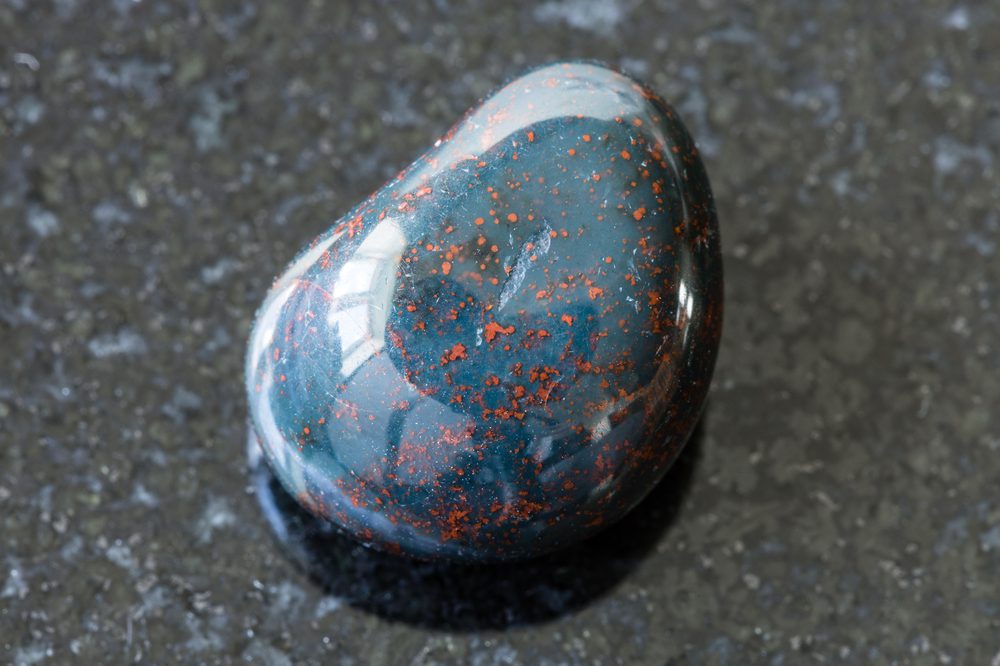The mineral heliotrope, popularly known as bloodstone, is a type of quartz that has attracted a particularly rich vein of stories and legends that date back at least as far as Roman times. Perhaps the most interesting thing about these is that at least one is easy to test, yet people keep on believing it nevertheless.
Bloodstone is primarily green with small red spots. The spots look enough like blood that Christian legend attributes the stone to vital fluids falling from Jesus on the cross. Those who told this tale were not aware of bloodstone’s relative abundance in Australia or the Americas, but it might be interesting to learn how they explained the stones getting from the Middle East to Eastern Europe or India.
What is the composition of a bloodstone?
Bloodstone is a form of silica, or silicon dioxide. As the two most common elements in the Earth’s crust, oxygen and silicon combine frequently, making up most of the sand on beaches, for example. Sometimes, however, instead of forming white grains or translucent rocks the pair can combine with traces of other elements to take on distinctive colors and crystal forms while still belonging to the quartz family. The predominant green of bloodstone is one. The name is used to refer to either jasper or green chalcedony. The red spots are incursions of hematite, a form of iron oxide (Fe2O3), which stands out well against the background.
The distinctive reds and greens of bloodstone. Image credit: vvoe/Shutterstock.com
Pliny the Elder and the history of bloodstones
Medieval Christians were not the first to associate the stone with blood and imbue it with magical powers. Pliny the Elder wrote: “When the stone is dropped into a vessel of water and bright sunshine falls upon it, in reflecting the sunlight it changes it into the color of blood. This is true especially of the Ethiopian variety.”
Post-Enlightenment, many readers of this statement instinctively want to grab a bloodstone and drop it in water. Pliny, apparently, felt no such need and simply repeated the story despite the ease with which it can be refuted.
On the other hand, he did at least pour contempt on conjurers who claimed that joining the stone to the heliotrope plant and casting spells could render the wearer invisible. Heliotrope plants got their name from the way the flowers follow the Sun through the day. The mineral was named after them, because, in Pliny’s words: “The same stone catches the sunlight like a mirror and detects solar eclipses, showing the passage of the moon below the sun’s disc.” What this actually means is anyone’s guess, because if a solar eclipse is happening you don’t really need a stone to alert you.
In the context of stories like this, it is easy to dismiss the practice of Roman soldiers who wore the stone into battle and believed it would slow bleeding if stabbed.
However, the Aztecs ascribed similar properties, particularly in powdered form, to the stone and the hematite may have had astringent effects that limited blood loss. Iron oxide is used in the astringent calamine today, although its contribution is thought to be different. Of course, the soldiers would have been better off with purer iron oxide samples, and there are certainly better options today, but their faith may not have been entirely deluded.
Modern myths of bloodstones’ healing powers
There is considerably less evidence for crystal healers’ beliefs that “bloodstone can be used to improve focus and strengthen decision making.”
Indeed the addition: “Associated with the base chakra, bloodstone is a powerful healing stone that protects the mind from the stresses of everyday life. It’s perfect for those who find it difficult to relax and who think about things for longer than they should,” is completely unsubstantiated. We’ll certainly be thinking about how improbable and unverified the statement is longer than we should.
You don’t, of course, need to believe any of those things to think bloodstone is beautiful and want it for aesthetics or historical reasons. However, online prices suggest you’d be paying a premium because other people do.
Source Link: What Is Bloodstone Crystal?
